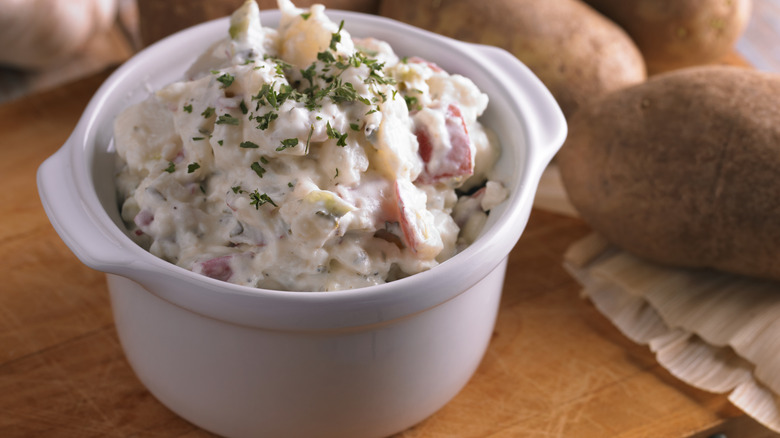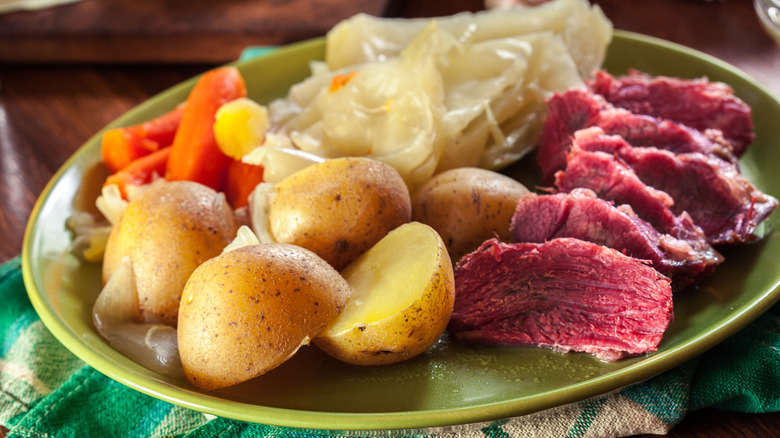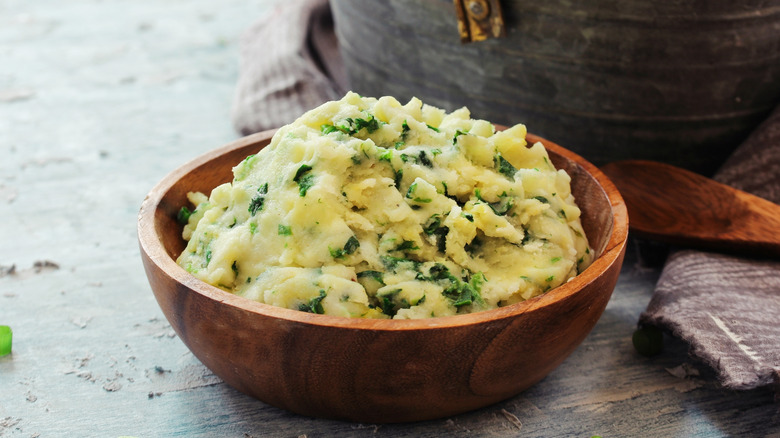Throw Some Corned Beef In Your Potato Salad For A St. Patrick's Day Upgrade
Besides drinking green beer, there's no better way to celebrate Saint Patrick's Day than eating a dish made with corned beef. The salty, tender meat is commonly put on sandwiches with sauerkraut or eaten alongside cabbage. For another tasty way to incorporate corned beef into your St. Patrick's Day feast, try mixing it into your potato salad. Simply dice your cooked corned beef and mix the bits into your favorite potato salad recipe for an upgraded, meat-filled side dish that your friends and family will be sure to love. It's kind of like putting bacon in your salad, but with a heartier, meatier bite that will fill you up and prepare you for any St. Paddy's Day-related activities.
Corned beef is typically a cut of brisket that's been cured for several days in salt water, spices, and herbs, which typically include black peppercorn, mustard seed, coriander, red pepper flakes, anise seeds, and bay leaves. Despite the name, there's no corn involved in this brined and roasted meat. The name "corned beef" dates back to the 17th century and refers to the large kernels of rock salt that were used to preserve the meat. The salty, slightly sour flavor of the beef pairs perfectly with earthy vegetables like potatoes and carrots. Try adding ingredients like shredded cabbage and dill pickle as well to your potato salad to complement the spiced meatiness of the corned beef.
Why do we eat corned beef on St. Patrick's Day?
Corned beef came out of the Cattle Acts of the 1660s, in which the English parliament outlawed cattle exports to England, keeping more cows in Ireland and making meat more affordable for the Irish (via Food & Wine). Thanks to a significantly lower salt tax compared to their English neighbors, Ireland was able to produce higher-quality corned beef using excellent salt imported typically from Spain and Portugal. During the 17th and 18th centuries, the Irish city of Cork was the hub for the corned beef trade. As a cured meat, it was perfect for long-distance travel and grew in demand across oceans and continents, causing prices to skyrocket until rural Irish people could no longer afford to eat it and turned instead to pork and potatoes. When Irish immigrants arrived in the United States, they found beef to be more plentiful and accessible than in their homeland and were able to recreate the dish. Today, corned beef is eaten more in the U.S. than in Ireland, but it is still considered a food representative of Irish heritage and culture.
Potatoes are commonly served alongside sliced corned beef. One could argue, then, that adding the brined meat to a creamy potato dish just makes sense. Besides the salty, meaty flavor boost, adding corned beef to your potato salad is also like doubling your Irish pride. Potatoes are a well-known Irish staple, with deep roots dating back to the late 16th century, when the crop was first introduced to Ireland and became one of the most commonly eaten and available foods for the nation. Eating potatoes is a great way to celebrate Irish culture and commemorate the Great Irish Potato Famine of the 1840s, which resulted in a large number of Irish people migrating to the U.S. to avoid starvation and start a new life.
Other tasty St. Patrick's Day foods
For another way to incorporate corned beef in your St. Paddy's Day feast, try adding some to another traditional Irish side dish called colcannon. While potato salad consists of boiled chunks of potato and a creamy dressing, colcannon is a mixture of mashed potatoes and greens like cabbage, kale, or chard. You can mix in bacon or serve it with sliced or diced corned beef. This is also a great way to use your leftover corned beef in another dish that can be served post-St. Patrick's Day.
Of course, the meal wouldn't be complete without a tasty green drink. If you're not a green beer fan, try making a refreshing green cocktail for your St. Patrick's Day party. You don't have to use food dye in your cocktails (or mocktails) — the green color can come from fruits and vegetables like spinach, basil, pear, honeydew melon, cucumber, and lime, for something that not only looks festive, but also tastes invigorating and scrumptious.


